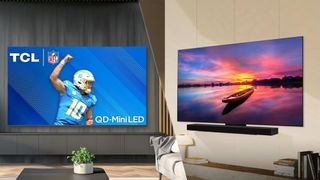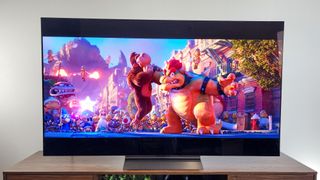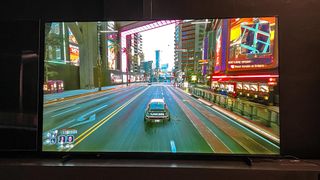
Serving at the second spot under their respective flagship displays, the TCL QM8 Mini-LED TV and LG C4 OLED are primed to steal the show this year as among the best TVs. Both have some tantalizing advantages between them and will offer you incredible immersion in everything from conventional entertainment to video gaming.
While a bit expensive over the LG C3 OLED, the LG C4 wraps a slew of awesome features on an advanced WOLED panel. With four total HDMI 2.1 inputs and a well-rounded Game Optimizer on a system that includes both FreeSync and G-Sync, it's set to be a surefire hit among gamers.
The TCL QM8 Mini-LED TV, on the other hand, is far less expensive yet still brings to the table ample premium specs that might make it stand as one of the best 65-inch TVs of the year. It leverages TCL's brand new QD-Mini-LED display ecosystem that fuses a 6-in-1 LED chip, ODR technology, and a wide-angle lens for unparalleled control over blooming, contrasts, and upscaling.
Let's take a peek and see if TCL's aim to beat OLED with its new technology can be felt in the wake of the launch of LG's 2024 TV lineup. Pitting the TCL QM8 against the LG C4 OLED in everything from price to audio, we'll get a better picture on what the TV market has to bring this year and see just how far Mini-LEDs can fly.
TCL QM8 (2024) vs LG C4 OLED: Specs compared

| TCL QM8 | LG C4 OLED | |
|---|---|---|
| Sizes | 65", 75", 85", 98" | 42", 48", 55", 65", 77", 83" |
| Ports | 4 (2 HDMI 2.1) | 4 HDMI 2.1 |
| Resolution | 3,840 x 2,160p | 3,840 x 2,160p |
| HDR | HDR10, HDR10+, HLG, Dolby Vision | HDR10, HLG, Dolby Vision |
| Smart TV software | Google TV | webOS |
| ATSC 3.0 support? | Yes | No |
| Processor | AIPQ Pro | α9 AI Processor Gen7 |
| Price for 65-inch screen | $1,499 | $2,299 |
TCL QM8 (2024) vs LG C4 OLED: Design

The TCL QM8 vs LG C4 OLED debate is one that sees Mini-LEDs vs OLED technology. It remains one of the biggest debates in the TV industry, with pros and cons to each. Built on LG's award-winning WOLED panel, the C4 OLED also has a particular edge to it even in the face of TCL's exciting QD-Mini-LED technology.
At the forefront of LG's C4 OLED is the α9 AI Processor Gen7 chip, which powers everything from upscaling to its AI enhancements. It sports a 144Hz refresh rate with most of the HDR formats excluding HDR10+. The C4 is also built on LG's webOS platform, which has seen serval issues of late regarding hackable vulnerabilities.
The TCL QM8 has a slight advantage in its special features, which include IMAX Enhanced HDR certification, an anti-glare screen, and even a Game Accelerator for 240 VRR gaming at 1080p. It also runs on Google TV using TCL's brand-new AIPQ Engine. Unlike the LG C4 OLED, the QM8 has an ATSC 3.0 tuner, allowing it access to NextGen TV.
The QM8 uses Mini-LED backlighting on a full array local dimming design and a VA panel. This means that the QM8 will have significantly better brightness and contrast, potentially suffering slightly from blooming — a negative that TCL claims is moot thanks to its new QD-Mini-LED technology.
As for audio, the C4 uses a 40W 2.2-channel speaker system against the QM8's 2.1.2 channel system with 20W of juice. Rounding out their specs, the QM8 uses Wi-Fi 6 over the LG C4's Wi-Fi 5.
TCL QM8 (2024) vs LG C4 OLED: Performance

To put both TVs through their paces, we used an X-Rite i1 Pro spectrophotometer, a SpectraCal VideoForge Pro pattern generator, and Portrait Displays’ Calman TV-calibration software to take measurements on their brightness, color accuracy, color saturation, and latency.
An important facet to understand before diving into the numbers is that we were only allowed to test the TCL QM8 Mini-LED TV in vibrant mode, meaning that the numbers will be slightly off against the LG C4. Namely, input lag and Delta-E will be far lower than currently listed, but brightness potentials and color accuracy will remain relatively unchanged.
With that out of the way, it's clear that the QM8 is a shining beacon of luminance. With an SDR brightness that boasts over 3,000 nits on a 10% window in line with a peak HDR brightness of 5,085 nits, the QM8 is a star ready to implode. The LG C4 comes in with a measly 296 peak SDR luminance, showing just how far TCL's Mini-LEDs have come.
| TCL QM8 | LG C4 | |
|---|---|---|
| SDR Brightness (10%, in nits) | 3220.98 | 296 |
| Delta-E (lower is better) | 12.534 | 1.8201 |
| Rec. 709 Gamut Coverage | 99.9655% | 98.9136% |
| HDR Brightness (10%, in nits) | 5085 | 1049 |
| UHDA-P3 Gamut Coverage | 97.4% | 98.15% |
| Rec. 2020 Gamut Coverage | 73.86% | 72.27% |
| Input Lag (ms) | 112.6ms (in Vibrant Mode) | 12.9ms / 9.2ms (Boost) |
Where both displays will find major inroads is among the best gaming TVs. The C4 already has its counterpart handily beat with its OLED design, the de facto screen for most gamers, in addition to a 9.2ms input latency in Game Mode. But the QM8 has a neat trick up its sleeve in its own Game Accelerator, which allows the TV to drop resolution to 1080p and boost frames for unrivaled speed at 240 VRR.
The QM8 misses out on G-Sync compatibility, though, using AMD FreeSync Premium Pro for diminished screen tearing, whereas the C4 supports both. The C4 also comes equipped with a total of four HDMI 2.1 inputs where the QM8 just has two, which could make the former one of the best HDMI 2.1 TVs.
On the HDR front, you'll be missing out on HDR10+ when going with the LG C4, whereas the QM8 supports all current HDR formats. Both are neck and neck when it comes to their HDR color accuracy, with the QM8 and C4 scoring 97.4% and 98.15% on the UHDA-P3 scale, respectively.
Of all performance metrics, one of the most important yet least-considered is audio. The C4 OLED's 40W speaker definitely brings the oomph, and Dolby Atmos support means you won't need to get one of the best soundbars for bone-shaking clarity. Meanwhile, the QM8's 2.1.2-channel speaker brings an added layer of sound to the formula, but lacks in overall power delivery on just a 20W system.
TCL QM8 (2024) vs LG C4 OLED: Outlook

Looking at both side by side, it's clear that the QM8 has some serious chops and definitely stands tall with the best of them this year. With incredibly high brightness built on an anti-glare screen that's under $2,000, the QM8 might well will out even in the face of the C4's lauded WOLED screen.
It's a tough bout, one that really comes down to how much you're willing to spend. The QM8 is just $1,499 at most retailers, where the LG C4 OLED costs a whopping $2,299, both for the 65-inch models.
While OLED has always proven to be the king in the display market, TCL is gaining on the competition, best of all witnessed in 16.3% growth of unit sales circa 2023 against the previous year. With its new QD-Mini-LED TVs on hand, with pricing set at some of the lowest marks in the industry, TCL is vying for a quick and easy win in 2024 and the QM8 stands as the mascot of this endeavor.
Where the LG C4 OLED falters most is in its price. At well over $2,000 for its 65-inch model, it comes in at quite the premium for little advantages over the previous year's C3. The C4 OLED also has plenty of gaming abilities, but the QM8's new Game Accelerator 240 is a (pun fully intended) total game changer.
By choosing the QM8 you might be missing out on four HDMI 2.1 ports and G-Sync, but its highly improved brightness, expert control over black levels, and gaming suite make it a better overall value compared to the LG C4 OLED. Save a few bucks and get ample HDR support in the process, what's not to love?
More from Tom's Guide
Get the top Amazon Prime Day deals right in your inbox: Sign up now!
Receive the hottest deals and product recommendations alongside the biggest tech news from the Tom's Guide team straight to your inbox!

Ryan Epps is a Staff Writer under the TV/AV section at Tom's Guide focusing on TVs and projectors. When not researching PHOLEDs and writing about the next major innovation in the projector space, he's consuming random anime from the 90's, playing Dark Souls 3 again, or reading yet another Haruki Murakami novel.